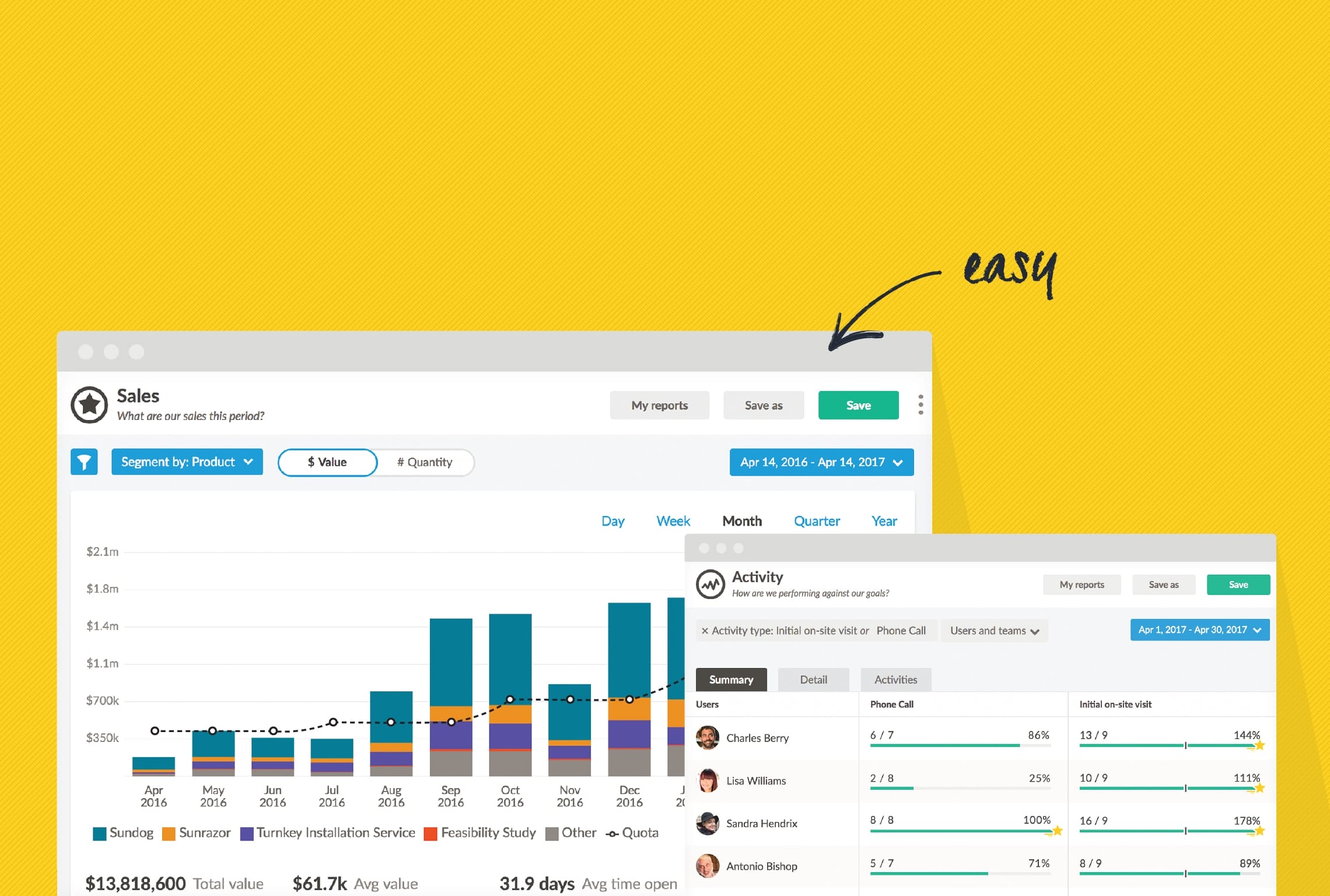See Nutshell in action!
Try Nutshell free for 14 days or let us show you around before you dive in.

Here’s the thing: email marketing can generate incredible ROI, but you have to have a solid strategy in place to see amazing results.
Keep reading to learn what email marketing ROI is, why you should track it for your company, how to calculate it in four steps, and more. Let’s dive in!
Email marketing return on investment (ROI) is a metric that measures the profitability of your email marketing campaigns. It considers the revenue generated through your campaigns and the expenses involved to help you determine how much value your email marketing efforts are providing your business.
Measuring the ROI of your email marketing efforts helps you determine whether your strategies are successful in driving more revenue for your business and helping you meet your email marketing goals, whether it’s increasing conversion rates or generating new leads. Unless you’re continually measuring ROI, your marketing team will be in the dark about whether their actions are bringing real value—and you might be missing out on valuable opportunities.
Email marketing can provide an ROI as high as 4400%, or $44 for every $1 invested.
ROI can vary considerably, however, based on factors such as the effectiveness of your strategy and content, the quality of your email list, and the goals you set for your campaigns.
Ultimately, you’ll need to consider your business’s unique needs and goals when evaluating how successful your email marketing is.
ROI is calculated by subtracting the initial value of an investment from the end value of the same investment in order to get a net return, then dividing the net return by the total costs accrued and, finally, multiplying this final figure by 100. Here’s the formula:
ROI = (Money Gained – Money Spent) / Costs x 100%
Email marketing ROI is found by applying this formula to your company’s email marketing strategy in order to discover the profitability of your efforts.
Here’s a better question: why don’t you want to track email marketing ROI?
It’s an incredibly useful metric that will help you determine if your email strategy is working or not. With this information, you can adjust your approach as needed to get better results.
Here are a few benefits you’ll enjoy once you start tracking email marketing ROI:
The B2B Marketer’s Toolkit collects 120+ of the best lead generation tips ever published on the Nutshell blog. Download it today!

Ready to discover your email marketing ROI? Follow these four steps to learn how effective your current email strategies are and whether you need to change your approach:
It can be tricky to track ROI for email marketing because there are so many things you can achieve with this strategy. Better brand awareness? Check. Consistent lead nurturing? Check. More website traffic, additional sales, and higher revenue? Check, check, check.
That’s why you need to understand your goals before you start making ROI calculations.
Once you know what your email marketing tactics are trying to achieve, you’ll be able to track ROI much more accurately. This is because you’ll have a better idea of both the costs involved and the benefits achieved by your efforts.
Next, round up every dollar spent on email over the past month, quarter, year—whatever time frame you’re looking to track email marketing ROI for. This will include:
You can’t succeed at email marketing without reliable software. And most email marketing software worth your time costs money to use. Tally up the amount you’ve spent on your ESP, email analytics and design platforms, and any other kind of tool you use to send email campaigns.
Here’s where things might get a little tricky. Unless your employees work for you for free, they represent a cost that must be factored in. Make your best guess as to the number of hours your team spends on email marketing. Then, convert this number into an hourly rate.
Have you spent money on anything that doesn’t fall into the two categories above but still pertains to your email marketing efforts? Make sure to include all purchased images, consulting fees, etc. in your email marketing ROI calculations.
Now it’s time to calculate the value derived from your email marketing efforts.
This is easy to do if you sell products and/or services online. But remember, sales aren’t the only value that email marketing generates. Leads should be taken into consideration, too.
The easiest way to tally sales and leads generated is by using Google Analytics, especially if your ESP integrates with the Google Analytics platform. Search your Analytics dashboard to find how many sales came from an email campaign within the time period you’re tracking.
Got that done? Perfect, now dive back into Analytics and search for conversions that can be attributed to your email campaigns. For our purposes here, a conversion is anything that might lead to a future sale: viewing a product page, downloading an eBook, etc.
Next, you need to determine what each lead is worth to your company, which can be done by multiplying the value of a product or service by its conversion rate.
So, if you sell a product that costs $49 and converts at 3%, a lead would be worth $1.47.
The last thing you need to do is add up your sales revenue and the estimated lead value. Returning to our previous example, if you sold 172 products at $49 and generated 386 leads at $1.47 each, your total email marketing gain would be $8,995.42.
Access email marketing and landing page software connected directly to your Nutshell CRM. Generate leads, organize contacts, segment audiences, track campaigns, and manage communications from a single tool!

Now that you have the data, you can simply insert it into the ROI formula mentioned above. Let’s use the figures from our previous examples to illustrate the formula in action…
Once you know the total value derived from your email marketing efforts and what it cost you to achieve those results, pinpointing your exact ROI is pretty simple!
Maybe you hate math. Or maybe you don’t use Google Analytics and don’t have a handy dashboard to tell you about conversions and such. Either way, we have a solution!
Sleeknote has designed a special calculator to help you determine your ROI for email marketing. All you have to do is input a few details, such as how many email subscribers you have, how much your email campaigns cost, your click-through and conversion rates, etc.
Then, the calculator will spit out an accurate ROI for your efforts. Give it a try here.
Once you’ve calculated your email marketing ROI, naturally, you’ll want to improve it. There are numerous things you can do to enhance your email marketing strategy. Here are some of the most useful for improving ROI.
Before starting a campaign, ensure you’ve clearly defined its goal, whether that’s driving sales, building brand awareness, or nurturing leads. A well-defined objective will not only guide your content but also allow you to measure success accurately. By pinpointing your campaign’s purpose, you’re on the path to maximizing your ROI, as each email you send will have a clear and compelling purpose.
The backbone of any successful email marketing strategy is the software you use. It’s not just about sending emails—it’s about delivering them effectively, analyzing performance, and automating processes to save time and boost efficiency. With the right email marketing software, you’ll have the tools to create eye-catching campaigns, segment your audience intelligently, and track results effortlessly.
When reading your emails, it should be clear what you want subscribers to do next, whether that’s visiting your website, shopping your online store, or signing up for a free trial.
With clear, compelling CTAs tied directly to your goals, you’re better able to track and improve your ROI.
In a crowded inbox, the key to capturing your audience’s attention and loyalty is providing genuine value. Each email you send should offer something meaningful, whether it’s informative content, exclusive discounts, or personalized recommendations. By consistently delivering value, you’ll not only keep subscribers engaged but also increase the likelihood of conversions, ultimately driving a higher ROI for your email marketing efforts.
One size does not fit all in email marketing. To boost your ROI, segment your audience based on their preferences, behaviors, and demographics. Then, sprinkle in some personalization to make your emails feel tailor-made for each recipient. Whether it’s addressing them by name, recommending products based on their past purchases, or sending personalized offers, these efforts can significantly enhance engagement, open rates, and, ultimately, your email marketing ROI.
A/B testing is a great tool for optimizing the performance of individual emails. With it, you can test elements of your emails like subject lines and preview text, design, and copy to see which version resonates most with your audience over a set time. Your email marketing tool should give you the ability to choose what criteria determine the winning version, what percentage of your audience should receive the tests, and how long to run the test before a winning variant is declared.
While your company’s email marketing ROI is a critical measuring stick for email marketing success, there are a few other metrics you need to be tracking as well. Ultimately, all of these metrics influence revenue, though it may be to varying degrees. Tracking all of the following metrics is the best way to dive deep into how your investment is actually generating revenue:
An email’s open rate is how frequently it’s opened by your subscribers. Open rate can tell you all sorts of things, like whether you’re writing captivating subject lines or sending your campaigns at the right time of day. But it shouldn’t be the only measurement of your email marketing success.
When more people are actually clicking through on your marketing emails, you’re probably doing something right. After all, every detail of how you craft the email—from subject line and content to design and CTAs—is chosen with a specific goal in mind.
Email marketing conversion rate refers to the number of recipients who completed an action you wanted them to take compared with the total number of email recipients. Conversion rate is an essential metric for identifying the effectiveness of your campaigns and can measure actions like filling out a linked form, downloading a white paper, signing up for an event, and purchasing a product.
Are your email subscriber lists clean? Bounce rate can tell you. This metric measures how many of your marketing emails return to you because they were unable to reach the sender—an issue that can be caused by numerous factors, including having outdated email addresses, your recipients aren’t opting in, or you’re being marked by email providers as a spammer.
You can calculate how many subscribers you’re losing by tracking unsubscribe rate. A high unsubscribe rate could mean you’re not reaching the right audience or sending valuable content, and it could result in your campaigns ending up in the spam folder.
Email marketing ROI is an important metric that, when used correctly, will help you boost brand awareness, drive more website traffic, and generate more revenue.
To find your ROI for email marketing, follow the four steps outlined in this post and know your goals, track your expenses, tally the value generated, and run the numbers through the ROI formula. Or just use Sleeknote’s handy ROI calculator instead.
Of course, before you calculate your email marketing ROI, you have to invest in a quality email marketing platform. If you haven’t done this yet—or can’t stand your current solution—give Nutshell a try. Our Email marketing tool puts the power to design, automate, and track email marketing campaigns back in your team’s hands—so you can generate more high-quality leads.
Sign up for a free 14-day trial today to see if Nutshell is right for your organization.
Try Nutshell free for 14 days or let us show you around before you dive in.


Join 30,000+ other sales and marketing professionals. Subscribe to our Sell to Win newsletter!
 Email & Calendar Sync
Email & Calendar Sync
Use our calculator to add up your total investment of CRM and Add-ons
VIEW ALL PRICING
 Product Info
Product Info Education & Guides
Education & Guides Company
Company